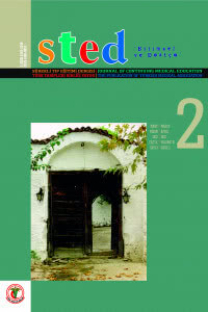Antalya il merkezinde bir grup yaşlıda geriatri sendrom bulgularına birinci basamak yaklaşımının değerlendirilmesi
The assessmentof primary health care approachfor geriatric syndrome symptomsina groupof elderlyin Antalya city center
___
- 1. CDC. Public health and aging: Trends in aging: United States and worldwide. MMWR Weekly 2003; 52(06): 101-6.
- 2. Towards age-friendly primary health care. Active ageing: Towards age-friendly primary health care. WHO Library Cataloguing-in Publication Data. Geneva: World Health Organization. 2004. Erişim 30 Mayıs 2011, http://whqlibdoc. who.int/publications/2004/9241592184.pdf
- 3. Kinsella K, Wan H. U.S. Census Bureau, international population reports, P95/09-1, An Aging World 2008. Washington DC: U.S. Government Printing Office; 2009.
- 4. Breyer F, Costa-Font J, Felder S. Ageing, health, and health care. Oxf Rev Econ Policy 2010; 26(4): 674-90.
- 5. Sekizinci Kalkınma Planı. Erişim 5 Aralık 2013, ekutup.dpt.gov.tr/plan/plan8.pdf
- 6. Dokuzuncu Kalkınma Planı. Erişim:5 Aralık 2013, ekutup.dpt.gov.tr/plan/plan9.pdf
- 7. Birinci basamak sağlık hizmetleri veri rehberi. Sağlık Bakanlığı Türkiye Halk Sağlığı Kurumu 2013. Erişim: 10 Aralık 2013, www.thsk.gov.tr/tr/dosya/TSBS/hsbs_rehber_ son.pdf.
- 8. Yaman H. Yaşlı sağlığı: Bütüncül geriyatrik değerlendirme. STED 2008; 17(11): 8-11.
- 9. Spalding MC, Sebesta SC. Geriatric screening and preventive care. Am Fam Physician 2008; 78 (2): 206-15.
- 10.EASY-Care Geriatrik Değerlendirme Anketi. Erişim 21 Şubat 2011, http://www.vasa.org.uk/ files/EASYCare_Standard_2010_December_ Version.pdf.
- 11.Yaman H, Akdeniz M, Howe J. GeroFam kavramı: Önümüzdeki demografik değişime yönelik bir çözüm önerisi. GeroFam 2010; 1(1): 1-14.
- 12.Wojszel ZB, BienB, Politynska B. The assessment of the functional state of elderlypeople by family physician with the help of EASY-Care questionnaire. Pol Merkur Lekarski 1999; 6(33): 167-70.
- 13.Bien B, Wojszel ZB, Wilmanska J. Care of the frail elderly in population studies. Pol Merkur Lekarski 2000; 9(53): 775-8.
- 14.Wham C, Carr R, Heller F. Country of origin predicts nutrition risk among community living older people. J Nutr Health Aging 2011; 15(4): 253-8.
- 15.Sharon K. Inouye, Stephanie Studenski, Mary E. Tinetti and George A. Kuchel, Geriatric syndromes: Clinical research and policy implications of a core geriatric concept. J Am Geriatr Soc 2007; 55(5): 780-91.
- 16.TC Türkiye İstatistik Kurumu. Demografik Nüfus Bilgileri. Erişim 3 Şubat 2012, http://www.tuik.gov.tr/Gosterge.do?metod= GostergeListe&tb_id=37&ust_id=11
- 17.Marengoni A. Patterns of chronic multimorbidity in the elderly population. J Am Geriatr Soc 2009; 57: 225-30.
- 18.Fortin M, Lapointe L, Hudon C, Vanasse A. Multimorbidity is common to family practice: is it commonly researched? Can Fam Physician 2005; 51: 244-5.
- 19.Tinetti ME. Performance-oriented assessment of mobility problems in elderly patients. J Am Geriatr Soc 1986; 34(2): 119-26.
- 20.Schäfer I, von Leitner EC, Schön G, Koller D, Hansen H, Kolonko T et al. Multimorbidity patterns in the elderly: a new approach of disease clustering identifies complex interrelations between chronic conditions. PLoS One 2010; 29; 5(12): e15941.
- 21.Mueller CA, Mielke RK, Penner E, Walker UJ, Pradier EH, Theile G. Disclosure of new health problems and intervention planning using a geriatric assessment in a primary care setting. Croat Med J 2010; 51: 493-500.
- 22.Piccoliori G, Gerolimon E, Abholz HH. Geriatric assessment in general practice using a screening instrument: is it worth the effort? Results of a South Tyrol study. Age and Ageing 2008; 37: 64752.
- ISSN: 1300-0853
- Yayın Aralığı: 6
- Başlangıç: 1992
- Yayıncı: -
Ev ziyaretleriyle ev kazası risk faktörlerinin saptanması ve belirlenen kazaların özellikleri
Kamer GÜR, SAİME EROL, Ayşe SEZER, FATMA NEVİN ŞİŞMAN
Simge YILMAZ, Abdurrahman ÇÖMLEKÇİ, Belgin ÜNAL
Köy ve kasaba ilköğretim okulu öğrencilerinin beslenme durumları
FUNDA ÖZPULAT, Birsen SİVRİ BİLGEN
Yenidoğanın anne ve baba ile bağlanma süreci
